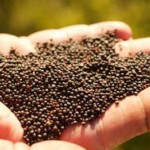 Happy New Year! The U.S. Canola Association wishes you a healthy and productive 2023!
Happy New Year! The U.S. Canola Association wishes you a healthy and productive 2023!
Just before Christmas, Congressional leaders passed an omnibus appropriations package for fiscal year 2023. The package totals $1.7 trillion, including $25.48 billion in discretionary funding for agriculture. The National Institute of Food and Agriculture’s Supplemental and Alternative Crops Competitive Grants Program, which funds the National Canola Research Program, increased to $2 million. As well, funding for agricultural disaster assistance, pesticide registration, climate change, conservation and agricultural research was put in place.
On Dec. 22, the Senate confirmed Alexis Taylor as U.S. Department of Agriculture (USDA) undersecretary for trade and foreign affairs, Jose Emilio Esteban as USDA undersecretary for food safety, and Doug McKalip as chief agricultural negotiator in the Office of the U.S. Trade Representative. More on agricultural appropriations are in the USCA Blog.

The U.S. Environmental Protection Agency (EPA) made a final determination on Dec. 1 that canola oil-based renewable diesel, jet fuel, naphtha, heating oil and liquified petroleum gas qualify as advanced biofuels under the Renewable Fuel Standard, reported Progressive Farmer, Biofuels International and DRG News among other agricultural media. That’s because these biofuels reduce greenhouse gas emissions by at least 50 percent compared to petroleum-based fuel. In fact, as noted in the U.S. Canola Association’s Dec. 1 news release, the EPA found that lifecycle GHG emissions from canola oil-based renewable diesel are 67 percent less than the diesel baseline and the other biofuels have similar reductions.
Barry Coleman, executive director of the Northern Canola Growers Association, discussed biofuel matters on Red River Farm Network’s “Canola Minute.” He noted the canola sector supports a multi-year extension of the biodiesel tax credit as well as an increase in national biomass-based diesel volumes.
 To help growers produce more canola to meet growing demand, the Canola Council of Canada has five suggestions:
To help growers produce more canola to meet growing demand, the Canola Council of Canada has five suggestions:
- Use 4R nutrient management practices (right rate, right source, right place, right time).
- Choose the best seed traits for each field.
- Achieve uniform planting of five to eight plants per square foot.
- Identify and manage the top yield robbers.
- Harvest all seeds and deliver them at No.1 grade.
Corteva Agriscience discussed new canola seed technology in an advertorial in Canada’s National Post. It noted that optimizing canola seed composition could be a major driver of the canola industry’s future economic growth. This includes using advanced plant breeding technologies to increase protein and decrease fiber in canola seed without compromising the quality, quantity, or composition of its oil.
 Why does Bobby Flay rarely cook with olive oil? Because he uses canola oil 98 percent of the time due to the oil’s neutral flavor and high smoke point. He believes food flavors do the work themselves in each dish, so oil should not interfere. Canola oil also has health benefits that Flay likes, including that it can lower bad cholesterol and promote heart health.
Why does Bobby Flay rarely cook with olive oil? Because he uses canola oil 98 percent of the time due to the oil’s neutral flavor and high smoke point. He believes food flavors do the work themselves in each dish, so oil should not interfere. Canola oil also has health benefits that Flay likes, including that it can lower bad cholesterol and promote heart health.
 Demand for canola will continue to increase in the coming years as the biofuel market continues to grow, predicts the Canadian Oilseed Processors Association. “The biofuel industry will be buying 6.5 million tonnes of the crop per year by 2030, up from 1.8 million tonnes in 2020,” it says, and biofuel will account for 23 percent of crop purchases by 2030. This change will make the canola market extremely volatile, which has traditionally been quite stable. Ultimately, this new demand will cause the price of canola oil and some foods to increase dramatically.
Demand for canola will continue to increase in the coming years as the biofuel market continues to grow, predicts the Canadian Oilseed Processors Association. “The biofuel industry will be buying 6.5 million tonnes of the crop per year by 2030, up from 1.8 million tonnes in 2020,” it says, and biofuel will account for 23 percent of crop purchases by 2030. This change will make the canola market extremely volatile, which has traditionally been quite stable. Ultimately, this new demand will cause the price of canola oil and some foods to increase dramatically.
Jim Everson, president of the Canola Council of Canada, was optimistic about canola in a state-of-the-industry address during Canola Week, especially because the EPA approved canola oil for use in five advanced biofuels under the RFS. “After weathering a couple of tough years, we’re seeing many promising signs of strong global demand,” he said. “We continue to see a growing appetite for healthier food products like canola oil, and a growing awareness of canola meal’s advantages as an animal feed ingredient. In addition to food and feed, we can add ‘environmental solutions’ to our list of diversification opportunities. The market for low-carbon fuels, to reduce GHG emissions is burgeoning, and it’s a great fit for canola.”

The Northern Canola Growers Association (NCGA) held its 25th Annual Canola Expo in conjunction with the Prairie Grains Conference Dec. 7-8 in Grand Forks, N.D. Daryl Ritchison of the North Dakota Ag Network reported on the weather outlook for 2023 and Mark Jirik of the Northern Crops Institute addressed the future of agriculture as keynote speakers. Drs. Ven Chapara and Jan Knodel also gave presentations on clubroot, verticilium stripe and new research findings on insect control.
The NCGA also held its annual meeting at the same time. Mike Brekhus of Kenmare, Matt Mongeon of Rolette and Tim Mickelson of Rolla were all re-elected to the board of directors. The NCGA also heard a proposal for a new method of reducing hail insurance rates for the canola industry from NAU Country Services.
The USCA’s spring board and annual membership meeting will be held in Washington, D.C., Tuesday-Thursday, March 14-16. More information about registering and booking accommodations can be found here.
Get social with us on Instagram, LinkedIn, Facebook, Twitter and YouTube.
Want to promote your products or services to canola producers and industry members? Visit our advertising pages to find specs, deadlines and rates to advertise in this monthly e-newsletter or on UScanola.com.
 Happy New Year! The U.S. Canola Association wishes you a healthy and productive 2023!
Happy New Year! The U.S. Canola Association wishes you a healthy and productive 2023!


 To help growers produce more canola to meet growing demand, the
To help growers produce more canola to meet growing demand, the  Why does
Why does  Demand for
Demand for 